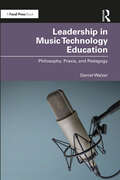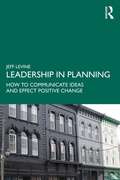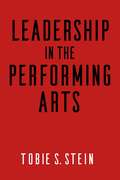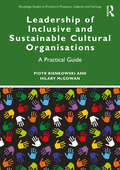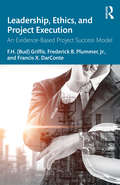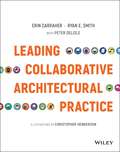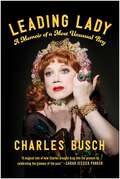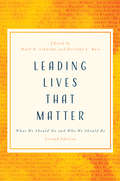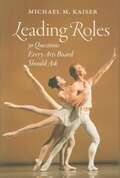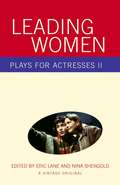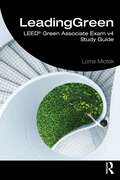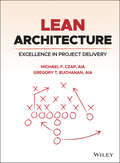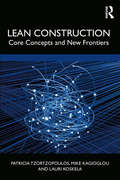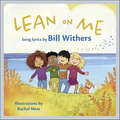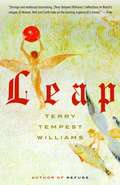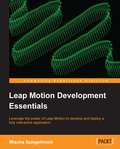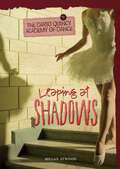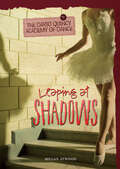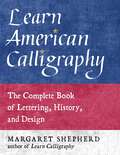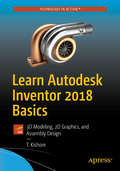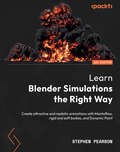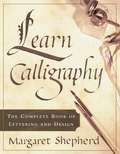- Table View
- List View
Leadership in Music Technology Education: Philosophy, Praxis, and Pedagogy
by Daniel WalzerLeadership in Music Technology Education examines the pedagogical, sociocultural, and philosophical issues that affect curriculum, research, and decision-making in music technology in higher education. This book considers a range of cutting-edge topics, including the impact of the COVID-19 pandemic, professional development concepts, partnerships between higher education and the creative and cultural industries, and the effects technology has on sustainability. Drawing on Leadership theories, including Transformational, Situational, Servant, and Social Change Model Theory, the book puts forward a new model, Creative Industry Leadership, which considers the sociocultural aspects of Music Technology Education, and interrogates biased ideologies that limit opportunities for a broad range of learners and practitioners in education and beyond. Additionally, Leadership in Music Technology Education examines educators’ informal leadership capacities during the COVID-19 pandemic and how inclusive pedagogy expands the creative boundaries of teaching, learning, and music-making for all. Leadership in Music Technology Education is crucial reading for instructors teaching audio engineering and music technology, as well as researchers in education, music pedagogy and related fields. This is also a valuable read for anyone with an interest in music technology and its many potentialities.
Leadership in Planning: How to Communicate Ideas and Effect Positive Change
by Jeff LevineBeing an effective city planner means being an effective leader. You need to be prepared to convince people that good planning matters. Often a well-written, thoughtful and inclusive plan doesn’t result in meaningful action, because planners don’t show leadership skills. At some point, some city planners become cynical and worn down, wondering why no one listens to them but not doing the self-reflection about how that could change. Leadership in Planning explains how to get support for planning initiatives so they don’t just fade from memory. It will guide city planners to think less about organizational charts and more about: · being a respected voice within your organization, both with staff and with your boss; · being a good communicator with people outside your organization; and · being able to understand how and when to push for good planning ideas to turn them into actions. Along the way, case studies bring these concepts to the real world of municipal planning. In addition, past planning figures’ actions are explored to see what they did right and what mistakes they made.
Leadership in the Performing Arts
by Tobie S. Stein Robert L. LynchWhat does it mean to be a performing arts leader? Leadership in the Performing Arts addresses and analyzes this question by presenting the wisdom and expertise of eleven men and women with experience leading nonprofit performing arts institutions in the United States. These successful leaders provide many real-world examples of business practices that may be generally applied by practitioners in our field, and throughout the nonprofit sector. The book examines: The leader’s career path and professional growthThe leader’s visionLeadership styles and the importance of interpersonal skillsSetting and executing organizational prioritiesLeading decision-making and communication processesCreating change and innovationChallenges faced in leading an institutionInterviewees include: Kathy Brown, executive director of the New York City Ballet; Peter Gelb, general manager of the Metropolitan Opera; Heather Hitchens, president of the American Theatre Wing; Karen Brooks Hopkins, president and chief executive officer of the Brooklyn Academy of Music; Timothy J. McClimon, president of the American Express Foundation; Laura Penn, executive director of the Stage Directors and Choreographers Society; Arlene Shuler, president and chief executive officer of New York City Center; Paul Tetreault, director of Ford's Theatre; Nancy Umanoff, executive director of the Mark Morris Dance Group; Patrick Willingham, executive director of The Public Theater; and Harold Wolpert, managing director of the Roundabout Theatre Company.Allworth Press, an imprint of Skyhorse Publishing, publishes a broad range of books on the visual and performing arts, with emphasis on the business of art. Our titles cover subjects such as graphic design, theater, branding, fine art, photography, interior design, writing, acting, film, how to start careers, business and legal forms, business practices, and more. While we don't aspire to publish a New York Times bestseller or a national bestseller, we are deeply committed to quality books that help creative professionals succeed and thrive. We often publish in areas overlooked by other publishers and welcome the author whose expertise can help our audience of readers.
Leadership of Inclusive and Sustainable Cultural Organisations: A Practical Guide (Routledge Guides to Practice in Museums, Galleries and Heritage)
by Piotr Bienkowski Hilary McGowanLeadership of Inclusive and Sustainable Cultural Organisations: A Practical Guide is the first book to provide guidance on how to lead cultural organisations that are inclusive, diverse and sustainable, and responsive to the public, their communities, their own staff and to popular movements.The book’s seven parts cover the qualities and skills a leader needs, and practical advice on how to develop an organisation that is sustainable, inclusive and diverse. It covers the role of the governing body, how to create an organisation that is constantly learning and adapting, how to deal with political, public and financial pressures, and what external sources of support they can call on. Each chapter is devoted to a specific issue that might be encountered on the leadership journey and is extensively cross-referenced to other relevant chapters.Including a list of helpful suggestions of useful and practical publications for further reading, Leadership of Inclusive and Sustainable Cultural Organisations is a unique guide to cultural leadership. This book is an essential resource for all cultural practitioners with a leadership role within an organisation or aspiring to such a role. It will also be instructive to students of cultural heritage management.
Leadership, Ethics, and Project Execution: An Evidence-Based Project Success Model
by F.H. (Bud) Griffis Frederick B. Plummer Francis X. DarConteLeadership, Ethics, and Project Execution provides a masterclass in the project and people management skills that set apart the most accomplished design and construction professionals. This textbook for graduate and advanced undergraduate students distils the insights gleaned over the authors’ decades of experience in academia and industry into actionable principles for success in a notoriously demanding field. Combining real life case studies with original research, Leadership, Ethics, and Project Execution points the way from the classroom to the jobsite. Interactive exercises allow readers to take the role of junior project managers and other emerging professionals and reason through the ethical dilemmas surrounding building projects from the initial bid to completion. Chapters on stakeholder alignment, productivity, and project success ensure that aspiring leaders’ business decisions are as economically sound as they are ethically correct. From its accessible, conversational tone to the lifetime’s worth of construction wisdom it shares, Leadership, Ethics, and Project Execution offers an extended mentoring session with three giants of the building industry.
Leading Collaborative Architectural Practice: Techniques From The Forefront
by Ryan E. Smith Erin CarraherThe groundbreaking guide to modern leadership in architectural practice Leading Collaborative Architectural Practice is the leadership handbook for today's design and construction professionals. Endorsed by the American Institute of Architects, this book describes the collaborative approach to leadership that is becoming increasingly prevalent in modern practice; gone are the days of authoritative "star" architects— today's practice is a brand, and requires the full input of every member of the team. This book builds off of a two-year AIA research project to provide a blueprint for effective leadership: the ability, awareness, and commitment to lead project teams who work together to accomplish the project's goals. Both group and individual hands-on exercises help facilitate implementation, and extensive case studies show how these techniques have helped real-world firms build exemplary success through collaborative teamwork and leadership. Highly illustrated and accessible, this approach is presented from the practicing architect's point of view—but the universal principles and time-tested methods also provide clear guidance for owners, contractors, engineers, project managers, and students. Build a culture of collaboration, commitment, and interpersonal awareness Adopt effective leadership techniques at the team, project, or practice level Handle conflict and resolve communication issues using tested approaches Learn how real-world projects use effective leadership to drive success The last decade has seen a sea-change in architectural leadership. New practices no longer adopt the name and identity of a single person, but create their own identity that represents the collaborative work of the entire group. Shifts in technology and changing workplace norms have made top-down management structures irrelevant, so what does it now mean to lead? Forefront presents effective contemporary leadership in the architectural practice, and real-world guidance on everyday implementation.
Leading Creators of Twentieth-Century Czech Theatre (Routledge Harwood Polish And East European Theatre Archive Ser. #Vol. 7)
by Jarka M. BurianIn this invaluable and detailed presentation of the leading creative figures in a richly innovative and dynamic period of Czech theatre, Professor Jarka M. Burian provides us with insightful portraits of the directors K. H. Hilar, E. F. Burian, Alfred Radok, and Otomar Krejca: of the famous Voskovec and Werich comedic duo; of the scenographer Josef Svoboda; and of the playwright, now President of the Czech Republic, Václav Havel. There are also briefer studies of numerous other directors, designers, and actors. The author, a Czech-American theatre scholar and practitioner, has been a frequent on-site observer of Czech theatre since 1965. He is directly acquainted with many of the major artists and the most notable productions that have made Czech theatre internationally famous.
Leading Lady: A Memoir of a Most Unusual Boy
by Charles BuschA poignant, deliciously anecdotal account of a talented artist's Oz-like journey in the worlds of Off-Broadway, Broadway, and Hollywood The Tony Award-nominated writer of The Tale of the Allergist&’s Wife and the long-running hit Off-Broadway play Vampire Lesbians of Sodom, and a Sundance Festival award winner, Charles Busch has created a unique place in the entertainment world as a playwright, LGBT icon, drag actor, director, and cabaret performer, with his extraordinary gift for both connecting with and channeling the leading ladies of show business. In wonderfully readable chapters, by turns comic and moving, Charles writes how ever since his mother's death when he was seven, he has sought out surrogate mothers in his life. In his teens, Charles moved to Park Avenue in Manhattan to live with his Auntie Mame-like Aunt Lil, who encouraged and nourished Charles&’ talents and dreams, and eventually he discovered his gifts for writing plays and performing as a male actress. Busch also shares his colorful and sometimes outlandish interactions with film and theatrical luminaries including the hilarious comedian Joan Rivers (who became a mother figure to Charles after Aunt Lil&’s death), Angela Lansbury (who attended her first Passover seder with Charles), Rosie O&’Donnell, Claudette Colbert, Valerie Harper, Kim Novak, and many others. Full of both humor and heart and featuring rare photos, Leading Lady is for readers of entertainment books as well as anyone who enjoys real-life stories of artists who break the mold, ditch the boundaries, and find their own unique way to sparkle.
Leading Lives That Matter: What We Should Do and Who We Should Be, 2nd ed.
by Mark R. Schwehn and Dorothy C. BassLeading Lives That Matter compiles a wide range of texts—from ancient and contemporary literature, social commentary, and philosophy—related to questions of vital interest for those who are trying to decide what to do with their lives and what kind of human beings they hope to become. This book draws upon both religious and secular wisdom, bringing these sources into conversation with one another. Mark Schwehn and Dorothy Bass identify four vocabularies typically used in discussions of the meaning of life choices: authenticity, virtue, exemplarity, and vocation. Six guiding questions shape the chapters that contain the majority of the texts. Each chapter&’s texts provide a variety of insights and approaches to be considered in addressing the question, arranged and introduced in ways that prompt deeper reflection. Leading Lives That Matter invites readers into arguments that have persisted for generations about what we human beings should do and who we should be. This second edition includes forty-seven new readings from a diverse array of writers, including Toni Morrison, Kazuo Ishiguro, Denise Levertov, Malcolm Gladwell, Julia Alvarez, Alice Walker, Martin Luther King Jr., Pope Francis, and Chung Tzu. Three new guiding questions have also been added: To whom and to what should I listen as I decide what work to do? With whom and for whom shall I live? What are my obligations to future human and other life?
Leading Roles: 50 Questions Every Arts Board Should Ask
by Michael M. KaiserNot-for-profit arts organizations struggled to survive the recent economic recession. In this increasingly hardscrabble environment, it is absolutely imperative that the boards of these organizations function as energetically, creatively, and efficiently as possible. Michael M. Kaiser’s personal history with boards of arts organizations began when he served on the board of the Washington Opera (now the Washington National Opera) in 1983. Today, in his capacity as president of the John F. Kennedy Center for the Performing Arts, Kaiser recently completed a 50-state, 69-city Arts in Crisis tour. Board issues came up repeatedly as central to the success or failure of the organization. Drawing on these and many other conversations, nationally and internationally, Kaiser’s book offers members of boards and staffs the information they need to create the healthy atmosphere necessary to thriving arts organizations. Organized in a clear, readable, question-and-answer format, Leading Roles covers every aspect of board participation in the life of the organization, including mission and governance; fundraising and marketing responsibilities; the relationship of the board to the artistic director, executive director, and staff; and its responsibilities for planning and budgeting. Kaiser addresses boards in crisis, international boards, and boards of arts organizations of color. Throughout, he emphasizes the importance of transparency and clarity in the board’s dealings with its own members and those of the arts community of which it is a part, showing how anything less results in contentiousness that can immobilize an arts organization, or even tear it apart.
Leading Women: Plays For Actresses II
by Eric Lane Nina ShengoldGather any group of actresses, from students to stars, and someone will inevitably ask, "Where are all the great roles for women?" The roles are right here, in this magnificently diverse collection of plays-full-lenghts, one-acts, and monologues--with mainly female casts, which represent the answer to any actress's prayer. The editors of the groundbreaking anthology Plays for Actresses have once again gathered an abundance of strong female roles in a selection of works by award-winning authors and cutting-edge newer voices, from Wendy Wasserstein and Christopher Durang to Claudia Shear, Eve Ensler, and Margaret Edson. The characters who populate these seven full-length plays, four ten-minute plays, and eleven monologues include a vivid cross-section of female experience: girl gang members, Southern debutantes, pilots, teachers, traffic reporters, and rebel teenagers. From a hilarious take on Medea to a taboo-breaking excerpt from The Vagina Monologues to a moving scene from the Pulitzer Prize-winning Wit, the plays in Leading Women are complex, funny, tragic, and always original--and a boon for talented actresses everywhere.
LeadingGreen: LEED® Green Associate Exam v4 Study Guide
by Lorne MlotekLeadingGreen: LEED® Green Associate Exam v4 Study Guide brings together a concise introduction to the core concepts behind the LEED green building rating system with efficient, effective test preparation for the LEED® Green Associate Exam. The guide provides an essential foundation in principles of sustainable design and construction for students and professionals in the areas of architecture, engineering, construction, real estate development, urban planning, and environmental policy. If you are interested in passing the LEED® Green Associate Exam, this is the right place to start. The background, objectives, and evolution of green building standards – as well as what actually goes into a LEED building – are covered in a clear and straightforward manner. Tailored to precise exam expectations, the guide breaks down the key LEED categories one credit at a time. Drawing upon the author’s extensive experience as a LEED educator for universities and professional firms around the world, the guide includes proven tips and tricks that have helped over 10,000 people pass the Green Associate Exam. An ideal resource for self-study, LeadingGreen: LEED® Green Associate Exam v4 Study Guide will benefit readers from all built environment professions in which LEED credentials are an asset.
Lean Architecture: Excellence in Project Delivery
by Michael F. Czap Gregory T. BuchananApply lean principles to your next architectural project and improve your bottom line with the help of this practical volume Lean Architecture: Excellence in Project Delivery shows readers a path to consistently achieve excellence in project delivery via the application of lean concepts and process management. Authors Michael Czap and Gregory Buchanan challenge readers to reexamine their approach to architectural practice and projects by presenting a unique and compelling alternative. Lean Architecture details the crucial metrics and implementation strategies that combine to improve the efficiency and profitability of projects taken on by firms of all sizes. Readers of the book will learn to: Maximize the use of their resources to deliver superior results in less time Minimize waste, cost, and inefficiency in their firm’s operations Move between radically different project scales while retaining efficient and effective processes Lean Architecture is perfect for firm leaders, project managers, and project architects who seek to improve their ability to deliver better results while reducing their cost base.
Lean Construction: Core Concepts and New Frontiers
by Michail Kagioglou Patricia Tzortzopoulos Lauri KoskelaThis book collates the main research developments around Lean Construction over the past 25 years with contributions from many seminal authors in the field. It takes stock of developments since the publication of Koskela’s (1992) Application of the New Production Philosophy to Construction and, in doing so, challenges current thinking and progress. It also crystallises theoretical conceptualisations and practically situated learning whilst identifying future research challenges, agendas and opportunities for global collaborative actions. The contributors present the development of Lean Construction as a fundamental part of improving construction productivity, quality and delivery of value to clients and users of built infrastructure. In doing so, the book introduces the reader to the foundational principles and theories that have influenced the way we now understand Lean Construction and has provided very useful insights to students, practitioners and researchers on key junctures over the last 25 years. Highlighting the key contemporary developments and using global case study material the chapters demonstrate good practice but also help introduce new thinking to both lay readers and experienced practitioners alike. This book is essential reading for undergraduate and postgraduate students, researchers and practitioners with an interest in Lean Construction and construction management, providing a general understanding of the area, current state of the art knowledge as well as providing an insight into areas for future research.
Lean on Me: ` (LyricPop #0)
by Bill WithersBill Withers's classic anthem to friendship lives on in this moving children's picture book adaptation."Lean on me When you’re not strong And I’ll be your friend I’ll help you carry on . . ." Lean on Me is an endearing children's picture book that beautifully demonstrates the power of friendship, based on Bill Withers's classic song of the same name. “Lean on Me” appeared on Withers's 1972 album Still Bill. The song reached #1 on the Billboard Hot 100 chart and ranked #208 on Rolling Stone's "500 Greatest Songs of All Time" list. With Withers's lyrics and illustrations by Rachel Moss, this picture book follows four close friends through the stages of their childhood, from elementary school until their high school graduation. Withers’s classic and loving refrain serenades them as they lean arm-in-arm into adulthood.
Leap
by Terry Tempest WilliamsSearing in its spiritual, intellectual, and emotional courage, Williams' divine journey enables her to realize the full extent of her faith and through her exquisite imagination opens our eyes to the splendor of the world.
Leap Motion Development Essentials
by Mischa SpiegelmockThis book is a fast-paced guide with practical examples that aims to help you understand and master the Leap Motion SDK.This book is for developers who are either involved in game development or who are looking to utilize Leap Motion technology in order to create brand new user interaction experiences to distinguish their products from the mass market. You should be comfortable with high-level languages and object-oriented development concepts in order to get the most out of this book.
Leaping at Shadows (The Dario Quincy Academy of Dance #1)
by Megan AtwoodMadeleine's the newest arrival at the famed Dario Quincy Academy of Dance. She's worked hard to gain admission, and she's determined not to lose her scholarship. That means not asking too many questions when her antique necklace goes missing, and certainly not breaking curfew. So how does she find herself exploring the creepy tunnels that run underneath the school? As if rivals at dance practice weren't bad enough, Madeleine begins to suspect that there's an ancient evil on the academy grounds. And when Madeleine and her rivals join together, sneaking out at night to explore the school's depths, the evil might just follow them back upstairs.
Leaping at Shadows (The\dario Quincy Academy Of Dance Ser.)
by Megan AtwoodMadeleine's the newest arrival at the famed Dario Quincy Academy of Dance. She's worked hard to gain admission, and she's determined not to lose her scholarship. That means not asking too many questions when her antique necklace goes missing, and certainly not breaking curfew. So how does she find herself exploring the creepy tunnels that run underneath the school? As if rivals at dance practice weren't bad enough, Madeleine begins to suspect that there's an ancient evil on the academy grounds. And when Madeleine and her rivals join together, sneaking out at night to explore the school's depths, the evil might just follow them back upstairs.
Learn American Calligraphy: The Complete Book of Lettering, History, and Design
by Margaret ShepherdTake a visual trip around the United States, with stop-offs in many locations and insights on every page, and illuminate the past and future of American calligraphy. For centuries, American calligraphers have accepted the legacy of the classic Roman, Gothic, and Italic calligraphy they inherited from Europe without realizing that there are more alphabet treasures to be found in a larger pool of uniquely American alphabet designs. Wild West, New Deal, Prairie—all were made in America, and they express ideas that reveal national character. These styles come from here and nowhere else. Much like American music, language, fashion, and philosophy, calligraphy has matured, moved on from its origins, and become, in the words of the man who created Spencerian handwriting, &“even more American.&” Learn American Calligraphy is the latest book from Margaret Shepherd, author of one of the all-time bestselling books on calligraphy, Learn Calligraphy. This new book focuses on American calligraphy, which has its own identity, distinct from the alphabets inherited from Europe. As a lifelong calligrapher, Shepherd surveys the landscape of unique styles and describes how two dozen alphabets originated and what shaped them. Simple diagrams and exercises help you try out the styles for yourself. Some letters represent a region or a major era of art; some bear witness to social upheaval or culture change; many are accessible to beginners; and a few contradict the established view of American history.
Learn Autodesk Inventor 2018 Basics: 3D Modeling, 2D Graphics, and Assembly Design
by T. KishoreGet started with the basics of part modeling, assembly modeling, presentations, and drawings in this step-by-step tutorial on Autodesk Inventor fundamentals. Next, this book teaches you some intermediate-level topics such as additional part modeling tools, sheet metal modeling, top-down assembly features, assembly joints, and dimension and annotations. Engaging explanations, practical examples, and step-by-step instructions make this tutorial book complete. Once you have read Learn Autodesk Inventor 2018 Basics you will be able to use Autodesk Inventor for 3D modeling, 2D drawings, finite element analysis, mold design, and other purposes, just like a design professional. You will gain all the basic information and essential skills you need to work in Autodesk Inventor immediately. What You'll Learn Carry out virtual 3D modeling for your next 3D printing projects Design molds for 3D printing and other projects Generate 2D drawings Who This Book Is For Novice users of Autodesk Inventor.
Learn Blender Simulations the Right Way: Create attractive and realistic animations with Mantaflow, rigid and soft bodies, and Dynamic Paint
by Stephen PearsonAn in-depth guide to using the power of Mantaflow, rigid body, soft body, cloth simulations, and Dynamic Paint in Blender 3.3 to create campfires, waterfalls, explosions, flags, and much moreKey FeaturesUnderstand Mantaflow to create fire and smoke simulationsLearn to design satisfying animations using soft bodies and the cloth simulationConstruct realistic physics animations with rigid bodiesBook DescriptionBlender is a free, open source 3D software that allows you to create stunning visual graphics, animation, VFX, and much more!This book is an in-depth guide to creating realistic and eye-catching simulations, understanding the various settings and options around their creation, and learning how to troubleshoot solutions to your own Blender problems. In addition, this book can also be used to simulate the behavior of certain physics effects, such as fire, fluid, soft bodies, and rigid bodies.You'll learn how to use Mantaflow, an open source framework within Blender software, to create fire, smoke, and fluid simulations. As you progress, you'll understand how to easily produce satisfying rigid and soft body simulations, along with cloth simulations. Finally, you'll use Dynamic Paint, Blender's modifier, and the physics system to create eye-catching animations.By the end of this Blender book, you'll have created a number of animations on your own, such as a campfire, waterfalls, and explosions. You'll also have gained a deeper understanding of all the simulation options in Blender, which you can use to create portfolio-ready animations.What you will learnDiscover what Mantaflow is and how to use it effectivelyUnderstand domains, flows, and effectors, and why they are importantCreate realistic fire, smoke, and fluid simulationsProduce satisfying soft and rigid body simulations with easeUse the cloth simulation to bring animated fabric to lifeExplore canvas and brush objects in Dynamic Paint to create eye-catching animationsWho this book is forIf you're a VFX artist, 3D artist, game designer, or any Blender user who wants to learn about Mantaflow and physics simulations, then this book is for you. You're expected to have basic knowledge of the Blender interface and how to use it.
Learn Blender Simulations the Right Way: Create attractive and realistic animations with Mantaflow, rigid and soft bodies, and Dynamic Paint
by Stephen PearsonAn in-depth guide to using the power of Mantaflow, rigid body, soft body, cloth simulations, and Dynamic Paint in Blender 3.3 to create campfires, waterfalls, explosions, flags, and much moreKey FeaturesUnderstand Mantaflow to create fire and smoke simulationsLearn to design satisfying animations using soft bodies and the cloth simulationConstruct realistic physics animations with rigid bodiesBook DescriptionBlender is a free, open source 3D software that allows you to create stunning visual graphics, animation, VFX, and much more! This book is an in-depth guide to creating realistic and eye-catching simulations, understanding the various settings and options around their creation, and learning how to troubleshoot solutions to your own Blender problems. In addition, this book can also be used to simulate the behavior of certain physics effects, such as fire, fluid, soft bodies, and rigid bodies. You’ll learn how to use Mantaflow, an open source framework within Blender software, to create fire, smoke, and fluid simulations. As you progress, you’ll understand how to easily produce satisfying rigid and soft body simulations, along with cloth simulations. Finally, you’ll use Dynamic Paint, Blender’s modifier, and the physics system to create eye-catching animations. By the end of this Blender book, you’ll have created a number of animations on your own, such as a campfire, waterfalls, and explosions. You’ll also have gained a deeper understanding of all the simulation options in Blender, which you can use to create portfolio-ready animations.What you will learnDiscover what Mantaflow is and how to use it effectivelyUnderstand domains, flows, and effectors, and why they are importantCreate realistic fire, smoke, and fluid simulationsProduce satisfying soft and rigid body simulations with easeUse the cloth simulation to bring animated fabric to lifeExplore canvas and brush objects in Dynamic Paint to create eye-catching animationsWho this book is forIf you’re a VFX artist, 3D artist, game designer, or any Blender user who wants to learn about Mantaflow and physics simulations, then this book is for you. You’re expected to have basic knowledge of the Blender interface and how to use it.
Learn Calligraphy: The Complete Book of Lettering and Design
by Margaret ShepherdIn an age of myriad computer fonts and instant communication, your handwriting style is increasingly a very personal creation. In this book, Margaret Shepherd, America's premier calligrapher, shows you that calligraphy is not simply a craft you can learn, but an elegant art form that you can make your own.Calligraphy remains perennially popular, often adorning wedding invitations, diplomas, and commercial signs. Whether it is Roman, Gothic, Celtic, Bookhand, or Italic style, calligraphy conveys class and elegance. Margaret Shepherd makes this ancient art form accessible in a completely hand-lettered technical guide that will:* Provide context for calligraphy as an art, exploring the rich tradition of hand-lettering and mapping the evolution of the most popular styles.* Give detailed technical advice on choosing pens, paper, and inks, setting up your workspace, mastering various pen angles, along with step-by-step illustrations to guide you as you practice. * Explain which alphabets are appropriate for different forms of writing. For example, the Roman alphabet works well for short, unpunctuated passages, while the Italic alphabet is more suited to informal everyday communication. * Encourage you to personalize your lettering by using variant strokes and interpreting how you would like the words to look on the page.* Inspire you with carefully chosen illustrations and examples, which bring letters to life.In Margaret Shepherd's own words, "Calligraphy trains not only your eye and hand, but your mind as well." Learn Calligraphy is the authoritative primer for this age-old craft, and will help develop a new appreciation for lettering as you discover your creative personality.
Learn Clip Studio Paint - Second Edition: Create Impressive Comics And Manga Art In World-class Graphics Software, 2nd Edition
by Liz StaleyIf you are a beginning digital artist or are switching to Clip Studio from another graphics software, this book is for you. This book is excellent for those with no knowledge of digital art up to intermediate users looking to explore the unique features of Clip Studio Paint.
